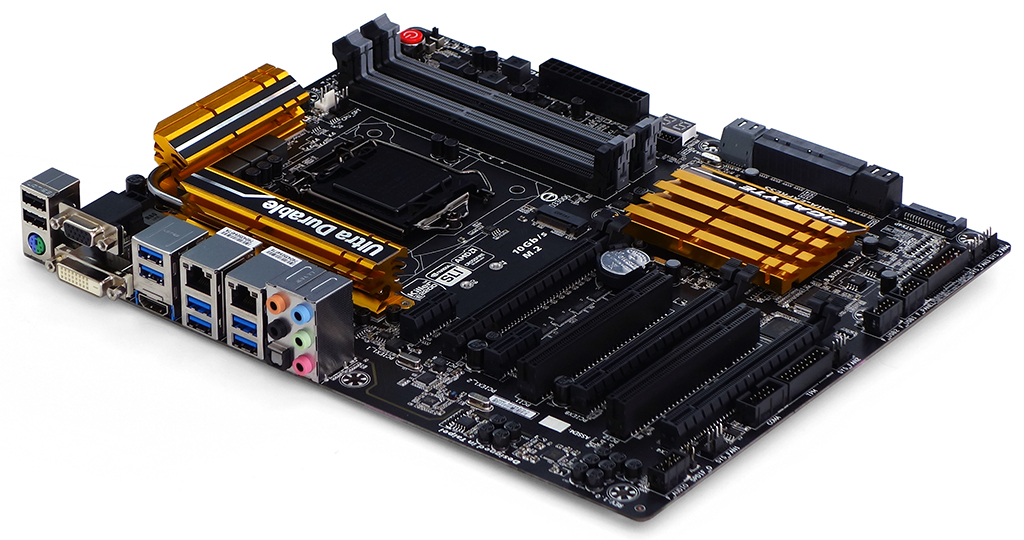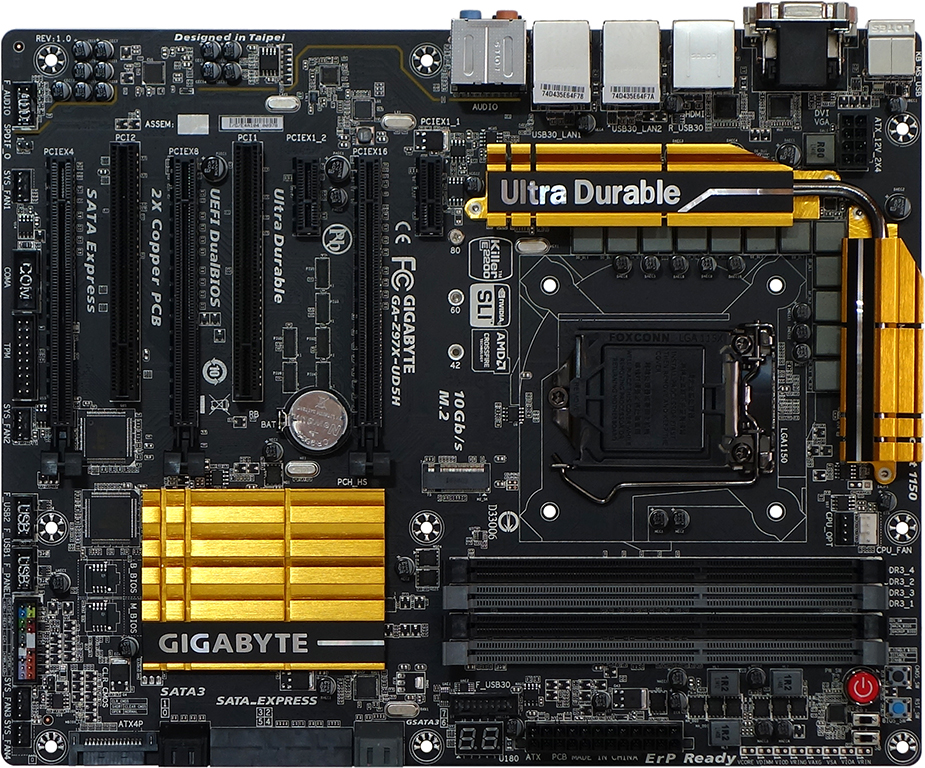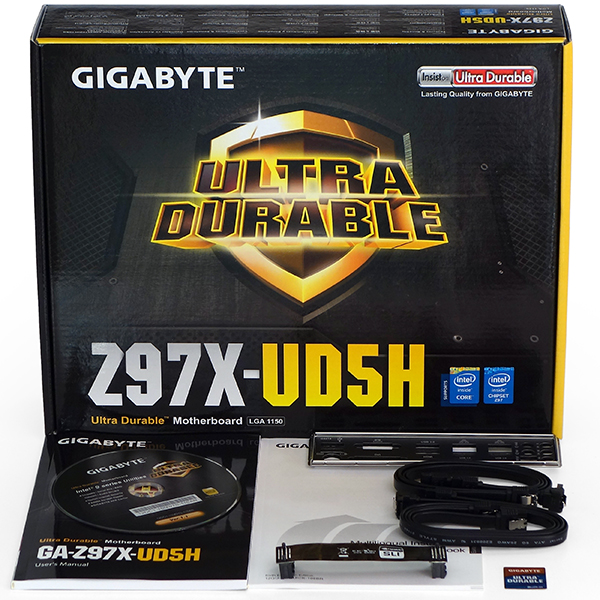Five Z97 Express Motherboards, $160 To $220, Reviewed
Intel’s “mainstream” socket continues to spawn enthusiast parts with the company’s fastest-ever gaming-oriented CPU. You’ll probably want a feature-packed motherboard for that, and five companies stepped up to show off the best of the sub-$220 segment.
Gigabyte Z97X-UD5H
Gigabyte packs its Z97X-UD5H with the dual networking controllers and six USB 3.0 ports of ASRock’s competing sample, plus the two USB 2.0 ports and VGA output of Asus’ board. How?
Though it probably has most of the features I'd personally use, the Z97X-UD5H is missing ASRock’s eSATA and I/O panel-based CLR_CMOS buttons, as well as the DiplayPort output both competitors expose. Gigabyte still manages to fill more space compared to Asus, though that company's second network connector is wireless. Keeping the balance of features in mind, Gigabyte also prices its Z97X-UD5H between the aforementioned competition.
The Z97X-UD5H is a completely different kind of product internally though, primarily because of its triple-graphics-optimized PCIe x16 slot configuration. Enthusiasts can switch between one card with 16-lane transfers, two with eight-lane links, or three cards in a x8-x4-x4 mode, all driven by the CPU's 16-lane controller at third-gen signaling rates. Though Nvidia precludes this configuration from three-way SLI compatibility, it works well in three-way CrossFire. AMD on Intel for the win?
Optimizing slots for CrossFire does have one disadvantage, though: any card placed into the third x16 interface kicks the middle slot into x4 mode. That’s something to keep in mind if you want to put something other than a graphics card there, especially since Nvidia dictates that you can't use x4 slots for SLI. Anyone with two GeForce cards will want to pretend that the Z97X-UD5H’s bottom slot isn’t even there. This is the same problem anyone buying ASRock's board faces if they decide to use the exclusive “Ultra M.2” feature, which borrows four PCIe 3.0 lanes. So, the debate between more graphics cards or faster storage begins here.
Keeping CrossFire in mind for the third slot, Gigabyte wisely omits bottom-edge USB 3.0 headers. We instead find a single two-port header near the middle of the front edge—right behind the diagnostics code display—where accessibility remains uncompromised.
SATA Express cables use two of the Z97X-UD5H’s eight SATA 6Gb/s ports. As with the previous competitors in today’s round-up, those two ports are lost whenever an M.2-based drive is installed. Unlike the other two companies, though, Gigabyte saves a PCIe 2.0 pathway by putting two legacy PCI slots on a single-lane PCIe-to-PCI bridge.
A closer look at the controllers shows that Gigabyte saves one more PCIe lane by putting the second gigabit Ethernet port on Intel’s proprietary-interface network controller. Getting some of its resources from the Z97 PCH, this WGI217V PHY would normally be called a primary controller, except that Gigabyte reserves the honor for Qualcomm’s PCIe-based Killer E2201. Enthusiasts who utilize the firm’s packet prioritization technology will hail the move, while those who don’t are left wondering why Gigabyte chose a combination of dissimilar parts that doesn’t support teaming.
Get Tom's Hardware's best news and in-depth reviews, straight to your inbox.
The corner in front of the DIMM slots is crowded with a bunch of tuner-friendly features, including a row of component voltage detection points, a power button for use without a case, a reset button for the freeze-ups caused by overzealous overclocking, a CLR_CMOS button to rid firmware of settings that won’t let it POST, a firmware ROM selector switch the helps power users get around corruptions, and a dual-BIOS mode selector that, from my experience, doesn’t. I leave that last capability turned off.
Gigabyte serves up the third motherboard in this round-up that includes only four SATA cables in spite of its large port count. That cost-saving move pushes value towards gaming enthusiasts by taking it away from storage enthusiasts, but perhaps the majority of storage enthusiasts have plenty of spare cables already?
-
Memnarchon At this price Asus could send a ROG product (Maximus VII Hero). I wonder why they choose to send the Z97-Pro instead...Reply -
bigshootr8 ReplyAt this price Asus could send a ROG product (Maximus VII Hero). I wonder why they choose to send the Z97-Pro instead...
My thoughts you can find the hero board within that price range quite easy. http://pcpartpicker.com/part/asus-motherboard-maximusviihero -
Drejeck I'd like some ITX Z97 and H97 with M.2 reviewed.Reply
I'm buying the Asus Z97i-plus because it just mount a 2x M.2 2280 and 2260, and all other connectivity goodness, uninterested in overclocking unless the broadwell i5 K consume less than 90W :D -
mapesdhs I recently bought a Z97I-Plus. Being so used to EATX boards as of late, I was a tadReply
stunned at how tiny even the packing box is. :D Just pairing it up with a G3258
initially to see how it behaves. Pondering a GTX 750 Ti, but kinda hoping NVIDIA
will release a newer version in Sept.
Ian.
-
Crashman Reply
They probably wanted to win based on features for the money? We know that the Wi-Fi ac has A $50 WI-FI CONTROLLER, what does the Hero add that's worth $50?13953852 said:At this price Asus could send a ROG product (Maximus VII Hero). I wonder why they choose to send the Z97-Pro instead...
-
lp231 The Asus ROG boards have a red line that lights up showing the audio path through it's build in LEDs, but the mainstream Z97 don't. I had a chance to take a look at one of the Asus Z97 board and took my phone's flash to shine in on it. The color was somewhat yellowish green and it looks really nice.Reply -
g-unit1111 I have a Z97 Extreme 6, it's a very nice board and it's definitely worthy of the approval award.Reply -
TechyInAZ Nice boards!! I love the gigabyte model but I like asus more because yellow heatsinks just don't fit in my opinion.Reply -
Memnarchon Reply
Hello. I think there are more reasons to buy a ROG product, instead of a Wi-Fi controller...13956156 said:
They probably wanted to win based on features for the money? We know that the Wi-Fi ac has A $50 WI-FI CONTROLLER, what does the Hero add that's worth $50?13953852 said:At this price Asus could send a ROG product (Maximus VII Hero). I wonder why they choose to send the Z97-Pro instead...
Better audio quality.
Better MOF-SETs.
Better inductors.
ROG BIOS.
Generally ROG boards have better quality parts.
But in the end we need the reviewers (like you) to review as many products as they can, so we can see the performance difference between them.



